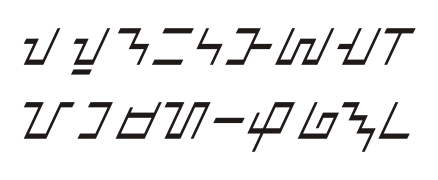Buhid script
Buhid is a Brahmic script indigenous to the Philippines, closely related to Baybayin and Hanunó'o, and is used today by the Mangyans, found mainly on island of Mindoro, to write their language, Buhid.
| Buhid (Mangyan Baybayin, Surat Mangyan) ᝊᝓᝑᝒ | |
|---|---|
 | |
| Type | |
| Languages | Buhid |
Time period | c. 1300–present |
Parent systems | Proto-Sinaitic alphabet
|
Sister systems | In the Philippines: Hanunó'o (Mangyan Baybayin, Surat Mangyan) In other countries: Balinese Batak Javanese Lontara Sundanese Rencong Rejang |
| Direction | Left-to-right |
| ISO 15924 | Buhd, 372 |
Unicode alias | Buhid |
Unicode range | U+1740–U+175F |
Structure
Consonants have an inherent /a/ vowel. The other two vowels are indicated by a diacritic above (for /i/) or below (for /u/) the consonant. Depending on the consonant, ligatures are formed, changing the shape of the consonant-vowel combination.[1] Vowels at the beginning of syllables are represented by their own, independent characters. Syllables ending in a consonant are written without the final consonant.[2]
| Buhid Vowels | |||||
|---|---|---|---|---|---|
| Initial | Dependent | ||||
| transcription | a | i | u | i | u |
| letter | ᝀ | ᝁ | ᝂ | ᝒ | ᝓ |
| Buhid Syllables[1] | ||||||||||||||||||
| transcription | k | g | ng | t | d | n | p | b | m | y | r | l | w | s | h | |||
| consonant + a | ᝃ | ᝄ | ᝅ | ᝆ | ᝇ | ᝈ | ᝉ | ᝊ | ᝋ | ᝌ | ᝍ | ᝎ | ᝏ | ᝐ | ᝑ | |||
| consonant + i | ᝃᝒ | ᝄᝒ | ᝅᝒ | ᝆᝒ | ᝇᝒ | ᝈᝒ | ᝉᝒ | ᝊᝒ | ᝋᝒ | ᝌᝒ | ᝍᝒ | ᝎᝒ | ᝏᝒ | ᝐᝒ | ᝑᝒ | |||
| consonant + u | ᝃᝓ | ᝄᝓ | ᝅᝓ | ᝆᝓ | ᝇᝓ | ᝈᝓ | ᝉᝓ | ᝊᝓ | ᝋᝓ | ᝌᝓ | ᝍᝓ | ᝎᝓ | ᝏᝓ | ᝐᝓ | ᝑᝓ | |||
Note: With the proper rendering support, the Buhid syllable ki above (ᝃᝒ) should resemble a plus sign (+).
Buhid writing makes use of single (᜵) and double (᜶) punctuation marks.[1]
Unicode
Buhid script was added to the Unicode Standard in March, 2002 with the release of version 3.2.
The Unicode block for Buhid is U+1740–U+175F:
| Buhid[1][2] Official Unicode Consortium code chart (PDF) | ||||||||||||||||
| 0 | 1 | 2 | 3 | 4 | 5 | 6 | 7 | 8 | 9 | A | B | C | D | E | F | |
| U+174x | ᝀ | ᝁ | ᝂ | ᝃ | ᝄ | ᝅ | ᝆ | ᝇ | ᝈ | ᝉ | ᝊ | ᝋ | ᝌ | ᝍ | ᝎ | ᝏ |
| U+175x | ᝐ | ᝑ | ᝒ | ᝓ | ||||||||||||
| Notes | ||||||||||||||||
Note: With the proper rendering support, the Buhid syllable ki above (ᝃᝒ) should resemble a plus sign (+).
Buhid writing makes use of single (᜵) and double (᜶) punctuation marks.[1]
See also
- Kulitan
- Kawi script
- Tagbanwa alphabet
- Filipino orthography
References
- "Chapter 17: Indonesia and Oceania" (PDF). Unicode Consortium. March 2020.
- Everson, Michael (1998-11-23). "N1933 Revised proposal for encoding the Philippine scripts in the UCS" (PDF).